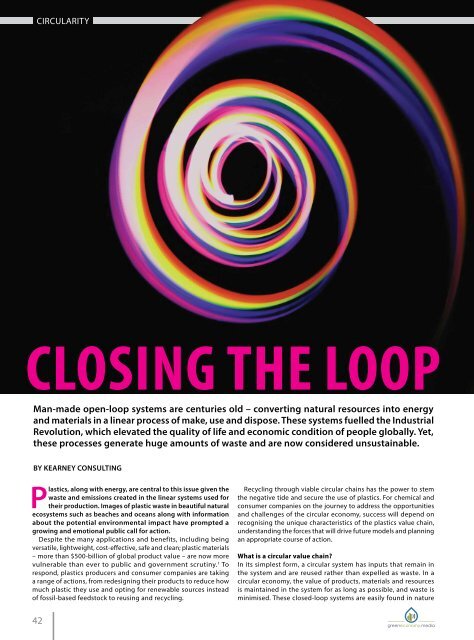Green Economy Journal Issue 63
Create successful ePaper yourself
Turn your PDF publications into a flip-book with our unique Google optimized e-Paper software.
CIRCULARITY<br />
CIRCULARITY<br />
(think water and biomass) but are less prevalent in man-made<br />
systems. Converting fossil fuels and minerals into energy and<br />
materials is a prime example of man-made open-loop processes in<br />
which finished products are discarded or accumulate in unwanted<br />
forms, such as CO 2 emissions.<br />
Exceptions do exist. Notably, 50% to 90% of aluminium is recycled<br />
(depending on the application), and other metals such as steel, copper<br />
and zinc also have recycling rates above 50%. 2 Nevertheless, only 9%<br />
of all human-produced end-of-life materials and energy are recycled.<br />
For plastics, that rate is 20%, with polyethylene terephthalate (PET)<br />
being among the highest at 29% to 58% across the US and Europe,<br />
leaving a significant opportunity on the table for recycling. 3<br />
What is special about plastics, and what are its circular scenarios?<br />
Chemical products, including plastics, have improved the quality<br />
of life for people across the globe over the past century. Useful<br />
properties and versatility combined with low cost have allowed<br />
these products to proliferate and deliver significant benefits<br />
to consumer convenience, industrial processes, logistics and<br />
public health. Unfortunately, these benefits have come with<br />
an environmental cost. Packaging, for example, accounts for at<br />
least a third of plastics usage and presents one of the most acute<br />
challenges for closing the loop.<br />
To understand the potential path to creating a circular value<br />
chain for plastics, it’s helpful to look at other materials that have<br />
similar usage patterns. For example, the aluminium value chain<br />
highlights some of the potential success factors while also revealing<br />
the unique factors that must be addressed for plastics. Historically,<br />
aluminium was mostly used for durable products in construction,<br />
transportation and other heavy industries. Although aluminium<br />
packaging had existed before, it accelerated in the 1960s with the<br />
explosive growth of beverage cans. As aluminium entered the public<br />
consciousness, with it came a call for recycling. The aluminium<br />
recycling process begins with collecting scrap at the point of use<br />
followed by aggregation, melting, purification and remixing with<br />
virgin feedstock (Figure 1).<br />
The main lessons from this closed-loop process include valuation<br />
of the scrap material to incentivise its capture, a mixed mechanical<br />
and chemical recycling value chain, purification technology and<br />
favourable economics that create a cost advantage for using recycled<br />
material rather than virgin feedstock.<br />
Recycling value chains for plastics are less well-established than<br />
those for metals. Single-material circular value chains, which we refer<br />
to as small-loop scenarios, are presently the most common, such<br />
as polyester material in PET bottles. The path forward for greater<br />
circular flows of plastic will involve a combination of plastics-specific<br />
small-loop scenarios and multiple-plastic, large-loop scenarios<br />
(Figure 2).<br />
Closed-loop value chain for aluminium<br />
CLOSING THE LOOP<br />
Man-made open-loop systems are centuries old – converting natural resources into energy<br />
and materials in a linear process of make, use and dispose. These systems fuelled the Industrial<br />
Revolution, which elevated the quality of life and economic condition of people globally. Yet,<br />
these processes generate huge amounts of waste and are now considered unsustainable.<br />
Figure 1. The metals industry has a well-established recycling process.<br />
Potential closed-loop value chains for plastics<br />
BY KEARNEY CONSULTING<br />
Plastics, along with energy, are central to this issue given the<br />
waste and emissions created in the linear systems used for<br />
their production. Images of plastic waste in beautiful natural<br />
ecosystems such as beaches and oceans along with information<br />
about the potential environmental impact have prompted a<br />
growing and emotional public call for action.<br />
Despite the many applications and benefits, including being<br />
versatile, lightweight, cost-effective, safe and clean; plastic materials<br />
– more than $500-billion of global product value – are now more<br />
vulnerable than ever to public and government scrutiny. 1 To<br />
respond, plastics producers and consumer companies are taking<br />
a range of actions, from redesigning their products to reduce how<br />
much plastic they use and opting for renewable sources instead<br />
of fossil-based feedstock to reusing and recycling.<br />
Recycling through viable circular chains has the power to stem<br />
the negative tide and secure the use of plastics. For chemical and<br />
consumer companies on the journey to address the opportunities<br />
and challenges of the circular economy, success will depend on<br />
recognising the unique characteristics of the plastics value chain,<br />
understanding the forces that will drive future models and planning<br />
an appropriate course of action.<br />
What is a circular value chain?<br />
In its simplest form, a circular system has inputs that remain in<br />
the system and are reused rather than expelled as waste. In a<br />
circular economy, the value of products, materials and resources<br />
is maintained in the system for as long as possible, and waste is<br />
minimised. These closed-loop systems are easily found in nature<br />
Figure 2. A circular system for plastics is likely to involve two closed-loop models.<br />
50% to 90% of<br />
aluminium is recycled.<br />
42<br />
43

















